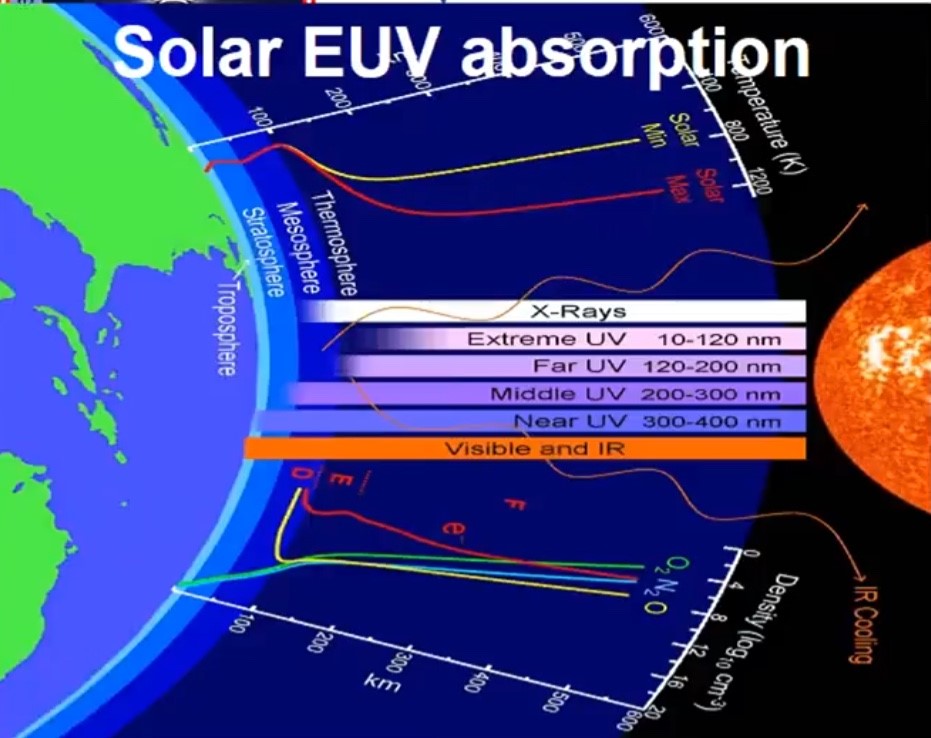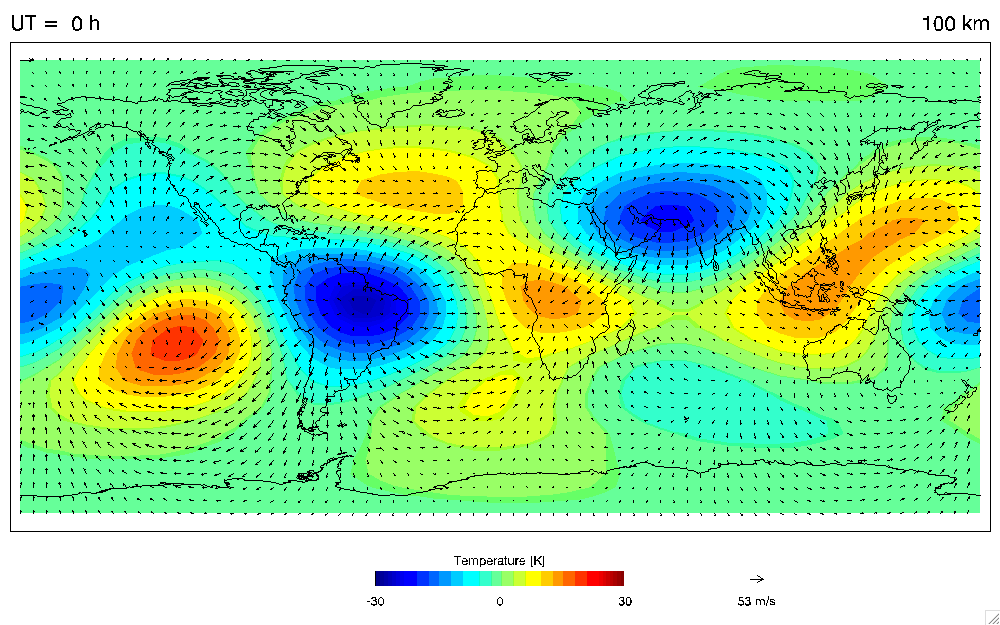GOLD, continued:
Atmospheric Tides
Atmospheric tides generate wind currents in the atmosphere that carry energy from the lower to the upper atmosphere. Partially caused each day by solar heating water vapor in the stratosphere, ozone in the troposphere, molecular oxygen and nitrogen in the thermosphere, they originate in the lower atmosphere starting out small as they travel through the denser lower atmosphere and becoming larger with faster currents as the atmosphere becomes less dense. GOLD will help to answer how high do these tides go, and where they deposit their energy.
Diurnal and semidiurnal tidal temperature and wind perturbation at 100 km altitude for September 2005 as seen by the TIDI and SABER instruments on board the TIMED satellite. Visualization of model of tides by Dr. Jens Oberheide (Click on image for video.)
These ripples in Earth’s upper atmosphere—waves and thermal tides—cause activity in the upper atmosphere. Hurricanes and tsunamis can also create waves that travel all the way into the upper atmosphere transferring energy that alters wind patterns of the upper atmosphere and causes other disruptions as they dissipate. The upper atmosphere is also impacted from space through solar storms generating extreme ultraviolet radiation, energized particles with electric and magnetic fields, and heating caused by a current that runs through our atmosphere.
Thermal Tides and Gravity Waves
The types of waves that significantly propagate from the lower atmosphere into the thermosphere are thermal tides and gravity waves. Thermal tides are forced by periodic heating of the Sun, they last fractions of a solar day in the thermosphere, and are planet-wide. They are measured in temperature, wind, and O/N2 ratios. There are two types of thermal tides. Migrating tides follow the motion of the Sun moving westward; non-migrating tides do not, moving instead eastward. As with ocean tides, thermal tides are relatively predictable and regular. Instead of high, low, ebb and flow, they are named by how often they occur, D=diurnal, S=semidiurnal, and T=terdiurnal, in what direction they flow, E=east and W=west, and how many peaks they have in their wave structure, as in DE3 which is a large once-per-day, eastward flowing tide that straddles the area above the equator, and is relatively large with a three-wave structure. Locally produced gravity waves are when gravity and buoyancy interact, last minutes to hours in the thermosphere, and are 10’s to 100’s of kilometers in size horizontally. Gravity waves are formed when a parcel of air is moved up in altitude, gravity pulls the air parcel back down bringing it even father down than it was originally, and then buoyancy boosts it back up. This process is repeated to create a small, local-scaled wave. As the wave propagates up from the lower to the middle, to the upper atmosphere, it grows in amplitude as the air becomes less dense. Eventually the wave will break depositing its eastward or westward momentum in the upper atmosphere. This can change the direction of the winds or generate entire circulations. Gravity waves are caused by orography when winds move over mountains or islands in the middle of the ocean. They are also caused by deep convection in very large thunder storms or hurricanes. Models depict gravity waves in the thermosphere as resembling waves made by a peddle dropped into a pond, beginning at one point and propagating in an every widening circular from that point. Gravity waves interact with other waves and tides in very complex and non-linear ways.
Space Weather
Space weather is caused by the solar corona that is formed by solar eruptions and extends far out into space propagated by supersonic solar winds. It controls the interplanetary magnetic field that surrounds Earth. The corona is driven by active regions of the Sun and their magnetic activity. The electromagnetic radiation of solar flares—gamma-rays to radio waves—and energized particles of solar flares and coronal mass ejections —photons, protons, electrons, and heavier nuclei—ejected during Solar eruptions effect Earth’s ionosphere. They disturb the solar wind and change the interplanetary magnetic field. When they reach the magnetosphere they cause reconnection deep within the magnetosphere of the Earth that connects to the magnetic polar regions of the Earth.
Energetic particles spiral down field lines into the upper atmosphere and ionosphere at high latitudes, the auroral oval. They connect the electric circuits of the magnetosphere with the ionosphere causing strong electrical currents, the auroral electro-jet, that flows along the auroral arcs and emit ultra violet light toward space and visible light as aurora toward Earth and heat. (Video courtesy NASA/GSFC–Click on image for video.)
Extreme Ultra-violet Radiation

Extreme ultra-violet radiation is made up of photons flowing from the Sun to Earth at about the speed of light. These photons that correspond to wavelengths 100 nanometers and shorter, are absorbed by ionizing the thermosphere stripping electrons to create the ionosphere at about 100 to 300 kilometers above the Earth. On the atomic level energetic electrons streaming in these currents collide with atomic and molecular oxygen and molecular nitrogen in the upper atmosphere. The energetic electrons excite the atmospheric electrons that decay and release photons. In addition to emitting ultra-violet and visible light, currents are created that release heat into the ionosphere and thermosphere especially at high latitudes that spreads to all latitudes. This process is called Joule heating. Solar activity is variable and the ionosphere becomes denser during solar maxima—cyclical periods of high solar emissions.
In the thermosphere the density and ratio of atomic nitrogen to atomic oxygen changes from lower atmosphere where molecular nitrogen is 80% and molecular oxygen is 20%. The thermosphere is less dense, and the molecules are no longer mixed by turbulence. They separate through diffusion and the amount of atomic oxygen increases as oxygen molecules are hit by photons in the solar wind, unbinding to form atomic oxygen. Lighter than molecular nitrogen, atomic oxygen rises on vertical wind into the upper thermosphere and become more abundant than molecular nitrogen. Vertical wind patterns in the thermosphere can be measured by recording variations in the 0/N2 density. Vertical wind patterns effect the horizontal circulation patterns of the thermosphere. However, ions are also moved in the thermosphere by chemical reactions with energized particles and electrical fields. Numerical models predict these complex movements, and data based on direct observations particularly during major space weather events will improve modeling and forecasting of upper atmosphere weather.

